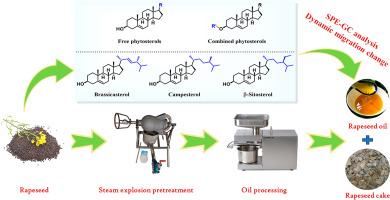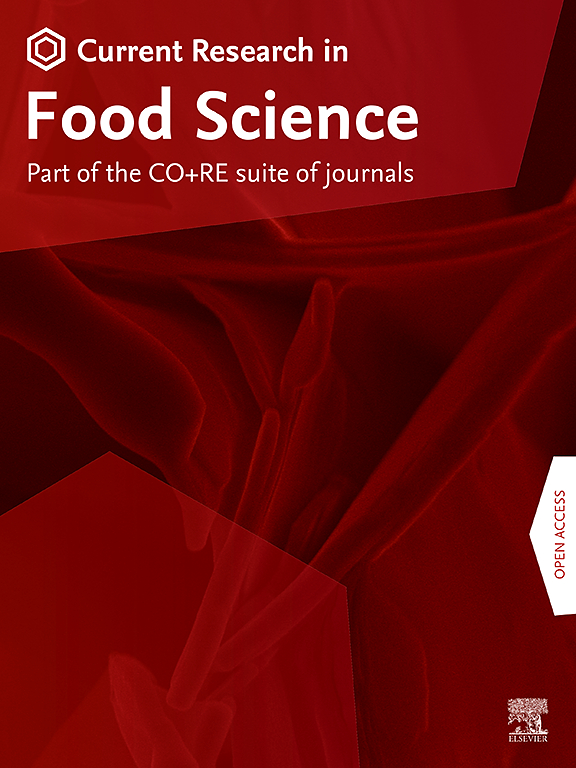Steam explosion pretreatment enhances free/combined phytosterol extraction and utilization in rapeseed (Brassica napus L.) and its processed products: Insights from SPE-GC approach
IF 6.2
2区 农林科学
Q1 FOOD SCIENCE & TECHNOLOGY
引用次数: 0
Abstract
The study investigates the impact of steam explosion pretreatment on the distribution of free and combined phytosterols within rapeseed and its derived products. Utilizing solid phase extraction-gas chromatography (SPE-GC) analysis, we elucidated the composition and distribution of phytosterols in five rapeseed varieties and their corresponding processed oils and cakes. The results indicated that Zhongyou 516 and Xiwang 988 are richer in combined phytosterols, whereas Dadi 199, Zhongyouza 501, and Xiwang 291 have a greater concentration of free phytosterols. Steam explosion pretreatment significantly increased the extraction proportion of combined phytosterols in rapeseeds. Throughout the oil process, more than half of the total phytosterol content, specifically 57.0%, was transferred from the steam explosion-treated rapeseed into the rapeseed oil. The variety Xiwang 291 showed the highest efficiency in this transfer, achieving a rate of 61.7%. The study provides crucial data for the enhancement of rapeseed processing techniques and the efficient utilization of phytosterols. Moreover, the study highlights the potential use of the ratio of free to combined phytosterols as a discriminator for different rapeseed oil varieties, offering valuable insights for quality assurance and product differentiation in the industry.

蒸汽爆破预处理可提高油菜籽(Brassica napus L.)及其加工产品中游离/复合植物甾醇的提取和利用:SPE-GC 方法的启示
本研究调查了汽爆预处理对油菜籽及其衍生产品中游离和组合植物甾醇分布的影响。利用固相萃取-气相色谱法(SPE-GC)分析,我们阐明了五个油菜籽品种及其相应加工油和油饼中植物甾醇的组成和分布。结果表明,中油 516 和西王 988 的组合植物甾醇含量较高,而大地 199、中油 501 和西王 291 的游离植物甾醇含量较高。蒸汽爆破预处理大大提高了油菜籽中组合植物甾醇的提取比例。在整个榨油过程中,植物甾醇总含量的一半以上(57.0%)从汽爆处理过的油菜籽转移到菜籽油中。品种西王 291 的转移效率最高,达到 61.7%。这项研究为提高油菜籽加工技术和植物甾醇的有效利用提供了重要数据。此外,该研究还强调了游离植物甾醇与组合植物甾醇之比作为不同菜籽油品种鉴别指标的潜在用途,为该行业的质量保证和产品差异化提供了有价值的见解。
本文章由计算机程序翻译,如有差异,请以英文原文为准。
求助全文
约1分钟内获得全文
求助全文
来源期刊

Current Research in Food Science
Agricultural and Biological Sciences-Food Science
CiteScore
7.40
自引率
3.20%
发文量
232
审稿时长
84 days
期刊介绍:
Current Research in Food Science is an international peer-reviewed journal dedicated to advancing the breadth of knowledge in the field of food science. It serves as a platform for publishing original research articles and short communications that encompass a wide array of topics, including food chemistry, physics, microbiology, nutrition, nutraceuticals, process and package engineering, materials science, food sustainability, and food security. By covering these diverse areas, the journal aims to provide a comprehensive source of the latest scientific findings and technological advancements that are shaping the future of the food industry. The journal's scope is designed to address the multidisciplinary nature of food science, reflecting its commitment to promoting innovation and ensuring the safety and quality of the food supply.
 求助内容:
求助内容: 应助结果提醒方式:
应助结果提醒方式:


